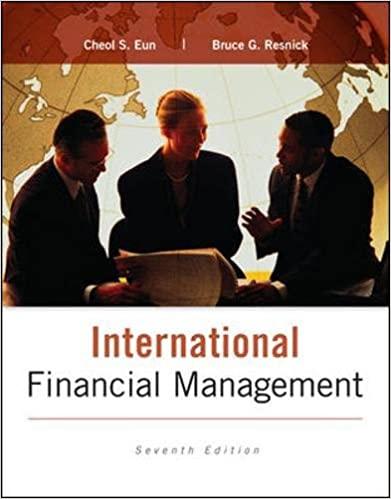It is Tuesday afternoon, February 14, 2012. Richard May, Assistant Treasurer at American Digital Graphics (ADG), sits
Question:
It is Tuesday afternoon, February 14, 2012. Richard May, Assistant Treasurer at American Digital Graphics (ADG), sits in his office on the thirty-fourth floor of the building that dominates Rockefeller Plaza’s west perimeter. It’s Valentine’s Day, and Richard and his wife have dinner reservations with another couple at Balthazar at 7:30. I must get this hedging memo done, thinks May, and get out of here. Foreign exchange options? I had better get the story straight before someone in the Finance Committee starts asking questions. Let’s see, there are two ways in which I can envision us using options now. One is to hedge a dividend due on September 15th from ADG Germany. The other is to hedge our upcoming payment to Matsumerda for their spring RAM chip statement. With the yen at 78 and increasing I’m glad we haven’t covered the payment so far, but now I’m getting nervous and I would like to protect my posterior. An option to buy yen on June 10 might be just the thing.
Before we delve any further into Richard May’s musings, let us learn a bit about ADG and about foreign exchange options. American Digital Graphics is a $12 billion sales company engaged in, among other things, the development, manufacture, and marketing of microprocessor-based equipment. Although 30 percent of the firm’s sales are currently abroad, the firm has full-fledged manufacturing facilities in only three foreign countries, Germany, Canada, and Brazil. An assembly plant in Singapore exists primarily to solder Japanese semiconductor chips onto circuit boards and to screw these into Brazilian-made boxes for shipment to the United States, Canada, and Germany. The German subsidiary has developed half of its sales to France, the Netherlands, and the United Kingdom, billing in euros. ADG Germany has accumulated a cash reserve of €900,000, worth $1,178,100 at today’s exchange rate. While the Hamburg office has automatic permission to repatriate €3 million, they have been urged to seek authorization to convert another €1 million by September 15th. The firm has an agreement to buy three hundred thousand RAM chips at ¥8000 each semi-annually, and it is this payment that will fall due on June 10th.
The conventional means of hedging exchange risk are forward or future contracts. These, however, are fixed and inviolable agreements. In many practical instances the hedger is uncertain whether foreign currency cash inflow or outflow will materialize. In such cases, what is needed is the right, but not the obligation, to buy or sell a designated quantity of a foreign currency at a specified price (exchange rate). This is precisely what a foreign exchange option provides.
A foreign exchange option gives the holder the right to buy or sell a designated quantity of a foreign currency at a specified exchange rate up to or at a stipulated date. The terminal date of the contract is called the expiration date (or maturity date).
If the option may be exercised before the expiration date, it is called an American option; if only at the expiration date, a European option. The party retaining the option is the option buyer; the party giving the option is the option seller (or writer). The exchange rate at which the option can be exercised is called the exercise price or strike price. The buyer of the option must pay the seller some amount, called the option price or the premium, for the rights involved.
The important feature of a foreign exchange option is that the holder of the option has the right, but not the obligation, to exercise it. He will only exercise it if the currency moves in a favorable direction. Thus, once you have paid for an option, you cannot lose, unlike a forward contract, where you are obliged to exchange the currencies and therefore will lose if the movement is unfavorable.
The disadvantage of an option contract, compared to a forward or futures contract is that you have to pay a price for the option, and this price or premium tends to be quite high for certain options. In general, the option’s price will be higher the greater the risk to the seller (and the greater the value to the buyer because this is a zero-sum game). The risk of a call option will be greater, and the premium higher, the higher the forward rate relative to the exercise price; after all, one can always lock in a profit by buying at the exercise price and selling at the forward rate. The chance that the option will be exercised profitably is also higher, the more volatile is the currency, and the longer the option has to run before it expires.
Returning to Richard May in his Rockefeller Center office, we find that he has been printing spot, forward and currency options, and futures quotations from the company’s Bloomberg terminal.
The option prices are quoted in U.S. cents per euro. Yen are quoted in hundredths of a cent. Looking at these prices, Richard realizes that he can work out how much the euro or yen would have to change to make the option worthwhile. Richard makes a mental note that ADG can typically borrow in the Eurocurrency market at LIBOR + 1% and lend at LIBID.
“I’ll attach these numbers to my memo,” mutters May, but the truth is he has yet to come to grips with the real question, which is when, if ever, are currency options a better means of hedging exchange risk for an international firm than traditional forward exchange contracts or future’s contracts. Please assist Mr. May in his analysis of currency hedging for his report to ADG’s
Finance Committee. In doing so, you may consult the highlighted market quotes below.
Step by Step Answer:

International Financial Management
ISBN: 9780077861605
7th Edition
Authors: Cheol Eun, Bruce Resnick





